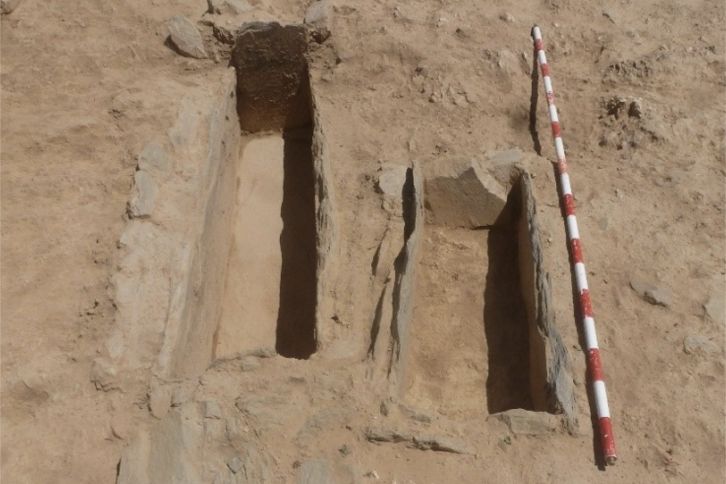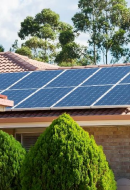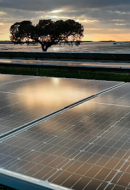Photovoltaic plants in Cedillo
Photovoltaic plants in Cedillo, an engineering challenge with minimum environmental impact
Operating plants Photovoltaic energy
As part of our commitment to renewable energies in Spain, we have commissioned two photovoltaic plants in Cedillo, Extremadura, with a combined installed capacity of 100 MW, plus a new 375 MW plant currently under construction. These facilities are designed to have the lowest possible environmental impact.

Photovoltaic plants of Cedillo




The Cedillo photovoltaic plant will supply 178,000 homes with clean energy
Our new large 375 MW photovoltaic project in Spain, located in the town of Cedillo in Cáceres, is a plant that will have sufficient capacity to supply 178,000 homes with clean energy, an amount comparable to, and even larger than, the population of Badajoz. Furthermore, its entry into operation will prevent the emission of 77,000 tonnes of CO2 per year.
The installation will have more than 576,000 bifacial photovoltaic panels, which are more efficient as they offer more useful surface area for capturing solar energy. The estimated production of this plant is 582,456 MWh of 100% green energy per year.
For its construction, we have the participation of local suppliers such as Faramax, from Malpartida de Plasencia, which will provide the transformers; IMEDEXA, from Casar de Cáceres, which contributes with the towers of the evacuation power line; and Ecoenergías del Guadiana, in charge of the environmental studies. These works imply a significant creation of local employment, with the generation of up to 800 jobs during peak periods.
The energy produced by the plant will be evacuated through an encapsulated substation that also serves the other two photovoltaic installations in Cedillo, with a combined capacity of 100 MW, and a hydroelectric plant of almost 500 MW in the same municipality.
This substation has been a major technological and logistical challenge to ensure minimum environmental impact in the surroundings of the Tagus International Natural Park, a protected area between Spain and Portugal. Manufactured in Italy and transported in containers weighing more than 50 tonnes, this infrastructure occupies only 300 m2, compared to the 10,000 m2 of land usually required for equipment of this type.

Photovoltaic Majada Alta and San Antonio



Plants of Majada Alta and San Antonio, in Cedillo
The Majada Alta and San Antonio photovoltaic plants, in the town of Cedillo in Cáceres, Spain, have a combined installed capacity of 100 MW (50 MW each). This facility came into operation in August 2022.
Their construction required us to overcome significant logistical challenges in order to ensure that an essential facility for the energy system had a minimal environmental impact. The company undertook a complex solution to jointly distribute the energy produced by these photovoltaic plants and the almost 500 MW hydroelectric power plant also located in the municipality to ensure minimal impact on the environment of the Alto Tajo Natural Park, a protected area between Spain and Portugal.
Faced with this challenge, Iberdrola España has installed a 300 kV encapsulated substation off-site in Italy. Prior to its on-site assembly, this installation undertook a complex journey by boat from Venice to Seville along the waters of the Guadalquivir and, from there, travelled through Andalusia and Extremadura in large trucks.
The substation was inserted in containers placed on a six-metre-deep structure, through which all the cables that distribute the power to the grid are connected. Each of these containers weighs more than 50 tonnes and large overhead cranes were needed to place them without interfering with the four evacuation lines of the hydroelectric power plant. A high-voltage challenge achieved thanks to the involvement of more than 300 local workers.
This innovative infrastructure also serves the Cedillo photovoltaic plant described above. In this way, it avoids installing more evacuation networks, which again favours the reduction of environmental impact and integration into the territory.

Video of the construction of the two plants, called Majada Alta and San Antonio.
Strong respect for the environment and cultural heritage
Iberdrola's commitment to the environment and respect for historical and cultural heritage is particularly relevant in the construction of projects such as Cedillo. In addition to undertaking important technical milestones to minimise the impact on nature, the company works to conserve important findings in the vicinity of the project.
During the clearing of the land prior to construction, which was carried out in compliance with the archaeological monitoring required by the regulations of the Junta de Extremadura, a pre-Romanesque necropolis and a dolmen were located and discovered. The necropolis (from the 5th century) has 32 tombs and six archaeologists worked on it, who were in charge of rescuing, cataloguing and documenting the discovery in order to make it available to the Junta de Extremadura. The dolmen is estimated to be between 3,500 and 4,000 years old.
Iberdrola also discovered a funerary stele that has been transferred to the Provincial Museum of Cáceres and is working with the authorities on the possibility of turning these findings into a point of tourist interest.




What is solar energy?
A sustainable and clean alternative to polluting energy sources.

Photovoltaic solar panels
What they are, types of panels and how they work.

Photovoltaic energy terms
Top 10 terms to know about photovoltaic energy.

Photovoltaic self-consumption
Discover this ally in the fight against climate change.
Iberdrola, world leader in renewable energies
At Iberdrola, we dare committed to renewable energy more than two decades ago as a fundamental pillar on which to build our safe, clean and competitive business model. Thanks to this vision, we are today world leaders in renewables, reaching 44,478 MW of clean energy in operation at the end of 2024.
This commitment is reflected in our Strategic Plan, in which we will allocate €15.5bn gross to renewables. More than half of this amount is focused on offshore wind in the US, UK, France and Germany; 28% on onshore wind and 18% on solar.




